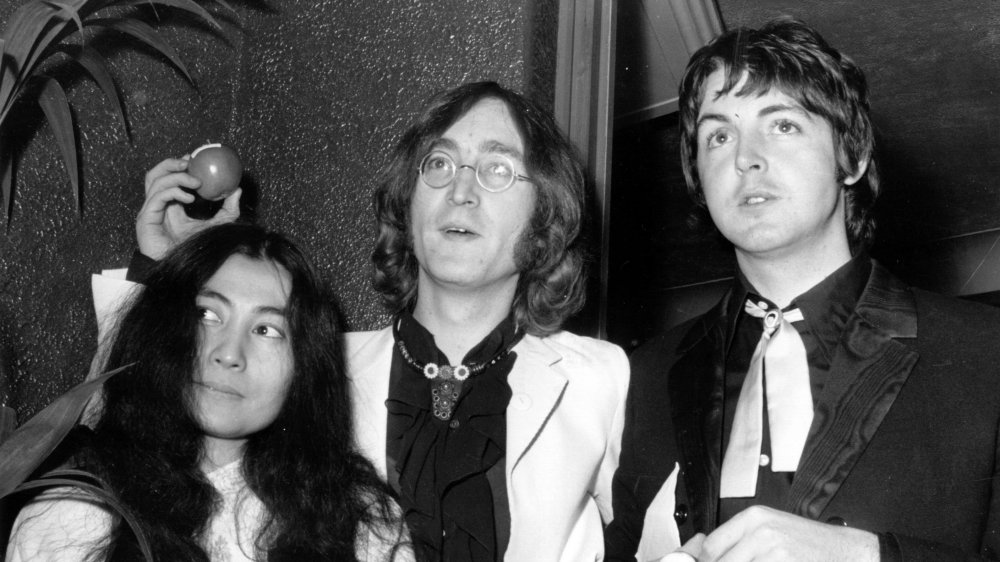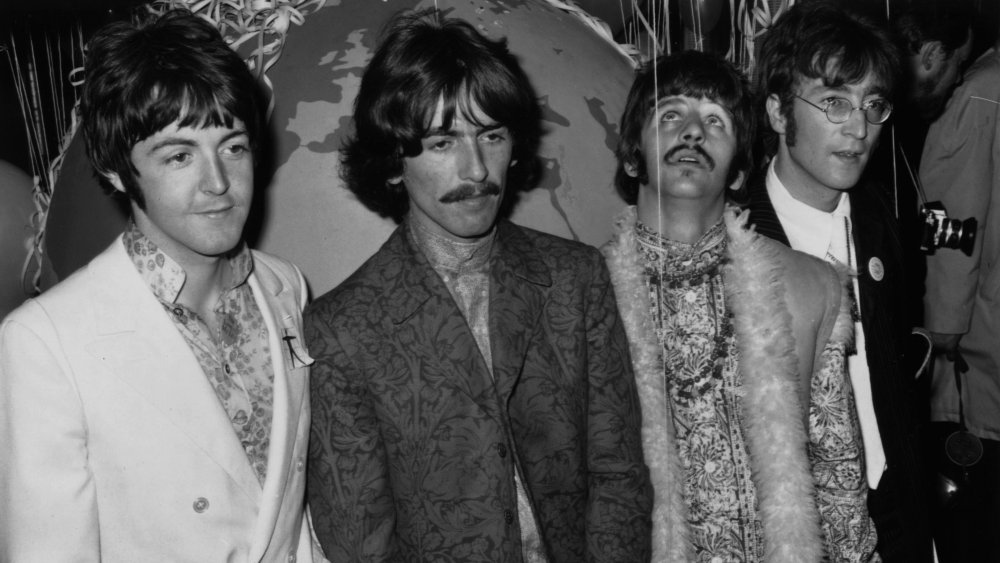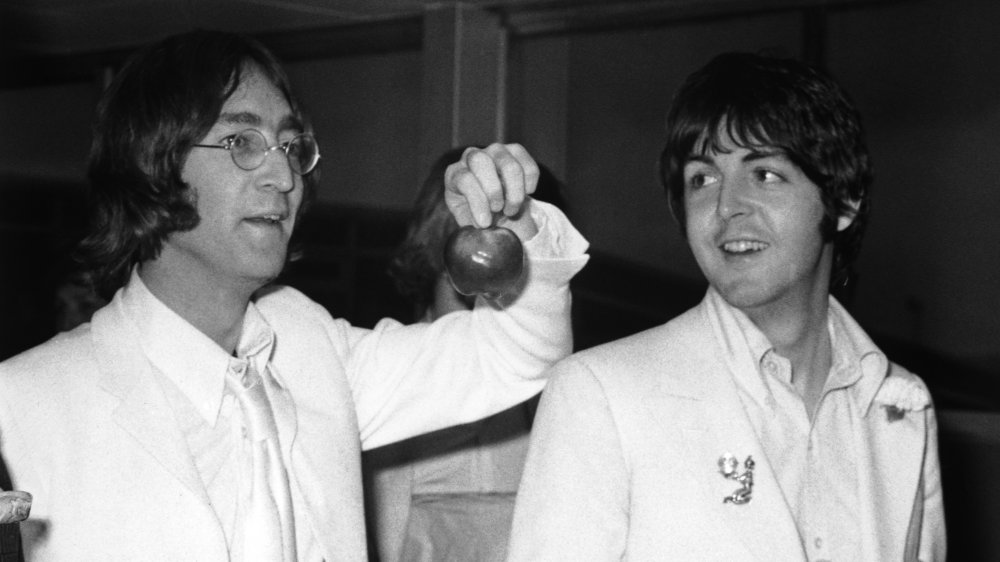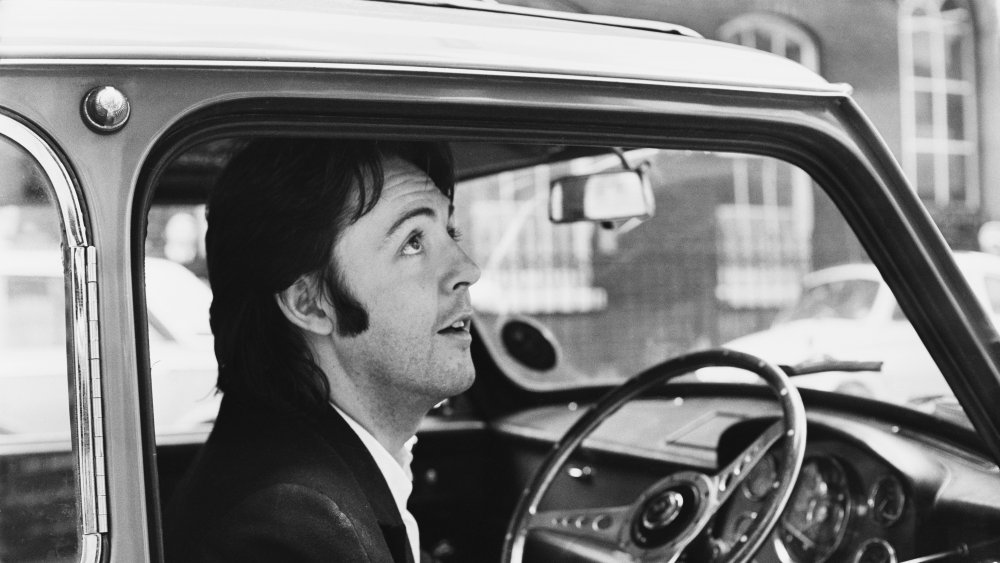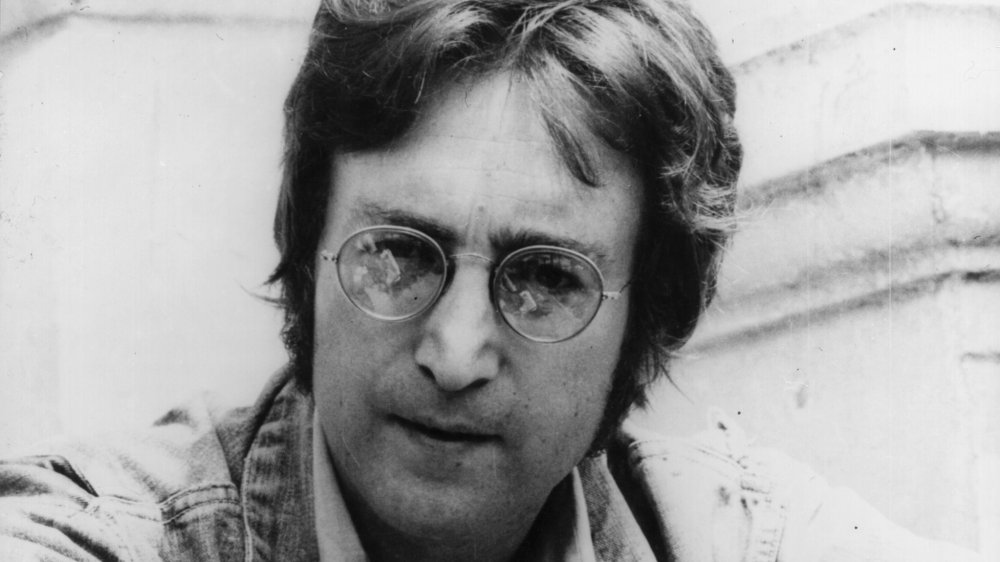The Break Up Of The Beatles Explained
Yoko Ono broke up the Beatles. Or at least, that's how many fans have seen it in the 50 years since the demise of the biggest band to have ever formed, whose short career together changed the face of popular music forever, leaving ripples of influence that can still be felt to this day.
In the press, the breakup of the Beatles occurred on April 10, 1970, following an ill — or perhaps, perfectly — timed press release from Paul McCartney that accompanied advanced press copies of his debut solo LP, McCartney. What followed was a period of well-documented acrimony in which John, Paul, George, and Ringo each separately gave conflicting accounts of the status of the band, the chances of ever playing again, and, most importantly for the music press, who exactly was responsible for the world's most popular music group bringing to a close an unprecedented period of critical and commercial success, which to this day has barely been matched.
The figure of Yoko Ono looms large in most debates over the downfall of the Beatles, and to say that she has been a scapegoat in their breakup would be something of an understatement. No one person can truly be said to be responsible, though another figure has become a more likely candidate than Yoko for the split. Here's the true account of the many factors that tore the Beatles apart, and the reasons why their breakup was, at the end of the day, inevitable.
The death of Brian Epstein
The story of the Beatles begins, of course, in Liverpool. Although the band had formed a smoking-hot stage show and a dedicated local following among the rock 'n' roll fans at the world-famous Cavern Club, it was in November 1961 that the group really took off, according to Biography, when, after catching one of their legendary performances, local businessman Brian Epstein offered to become the Beatles' manager.
"If anyone was the fifth Beatle, it was Brian," Paul McCartney would claim years later, after Epstein had guided the group to worldwide success. Epstein put the Beatles through a grueling touring schedule — including a performance for the royal family within six months of his meeting them — interspersed with ample studio time to capture their ever-improving sound. The trajectory that Epstein set the Beatles upon created the phenomenon we know today as "Beatlemania."
Epstein died suddenly of an accidental overdose on August 27, 1967, aged just 32. Though his abilities as a businessman have been up for debate in the years since his death, to the band, his loss meant that the following years lacked crucial guidance and focus, as well as a figure to act as arbiter in the band's creative disagreements, which would plague the Beatles until their eventual breakup just three years later.
The White Album: a breakup soundtrack?
"The break-up of the Beatles can be heard on that album," claimed John Lennon, regarding the 1968 double album The Beatles, known to most fans affectionately as The White Album due to its minimalist cover art. Paul McCartney later dubbed it "The Tension Album," according to the Independent, as a result of the fractious atmosphere that permeated the recording process. It was a sign of what was to come.
The White Album is now celebrated as some of the group's best work, featuring classic tracks such as "Back In The U.S.S.R." and "While My Guitar Gently Weeps." But the album is a collage of different creative directions, lacking the unity of Sgt. Pepper's Lonely Hearts Club Band, with personal differences between the band members reportedly leading to much of the album being recorded in three separate studios. Lennon took exception to the traditional forms of songwriting that McCartney was attempting to pursue, claiming that he was writing music for "grannies," while McCartney himself took exception to the avant-garde, experimental direction that Lennon, influenced by Yoko Ono, was taking. McCartney felt so strongly about the matter that he would later accuse Lennon of "sabotaging the Beatles."
Paul McCartney takes creative control
Within the vacuum created by the loss of Brian Epstein, Paul McCartney attempted to guide the creative side of the increasingly directionless group. He received much resistance from his bandmates, however, with George Harrison especially critical of McCartney's approach, which, according to Beatles Bible, the guitarist found overly domineering.
The result of McCartney's direction was the ill-fated Get Back sessions, which the Beatles considered an attempt to return the band to its roots (hence the title, though this has also been interpreted as a cryptic message to Yoko Ono, encouraging her to back away from the group). The project was an attempt to capture the rehearsals on film for a television special, beginning with regular recording sessions captured candidly on camera. The resulting conditions, however, led to much animosity, with Harrison briefly quitting the group in January 1969.
The project would ultimately be shelved as a costly misstep, with the material being reworked to form the basis of what would be the Beatles' final studio release, 1970's Let It Be.
Growing differences and "too much material"
The tensions that emerged during the recording of The White Album were not short-lived. With George Harrison continuing to grow as a songwriter, vying for space on albums with Lennon and McCartney compositions, the feeling that the Beatles were no longer a single unit but rather an umbrella term for separate identities became even more pronounced in their final releases.
Harrison complained bitterly of how readily his compositions were excluded from discussions of what would make the cut for album playlists. Indeed, the fact that his 1970 solo album All Things Must Pass was released as a triple LP came to prove his status as a prolific songwriter during the Beatles' final years.
"The trouble is that we've got too much material. Now that George is writing a lot we could put out a double-album every month, but they're so difficult to produce," Lennon claimed. According to McCartney Times, Harrison claimed that "we'd do 14 of their tunes, and then they'd condescend to listen to one of mine." The perceived lack of generosity on the part of his fellow Beatles formed the basis for Harrison's "My, Me, Mine," which also took aim at the group's hangers-on. The band's early unity and focus — reflected in their matching outfits — is strikingly contrasted with, for example, in the video to "Something," in which the four members walk separately but with their wives, signaling to fans that they were growing up and apart.
John Lennon, Yoko Ono, and heroin
It might not be fair to lay the blame for the breakup of the Beatles entirely at Yoko Ono's feet, but it can't be said that her relationship with John Lennon was entirely blameless. It has been well-documented that Ono was a near-ubiquitous presence in the Beatles' final years, with Lennon himself stating that he was unwilling to be without her company. As a result, Ono went wherever Lennon went, including recording sessions and band meetings, and would leave with Lennon for extended periods when his interest in the group waned.
The dependency of Lennon on Ono wasn't simply based on infatuation, however: Since around the time of the White Album sessions, the pair had begun using heroin, according to Salon. "This was a fairly big shocker for us," Paul McCartney later said, "because we all thought we were far-out boys, but we kind of understood that we'd never get quite that far-out."
The drug made Lennon more erratic and confrontational, hindered his performances, and further added to the sense that, along with Ono, he was retreating from his bandmates into his own private world. The strain was particularly felt in his relationship with George Harrison, with whom he'd had a long and creatively productive experimentation with psychedelics throughout the mid-stage of the band's career. Lennon and Ono would later go through rehab and record the song "Cold Turkey" about their experiences.
The mismanagement of Apple Corps
Years after the Beatles split — and, indeed, after John Lennon's life was tragically taken — Paul McCartney gave a wide-ranging interview to Rolling Stone that delved into the forces that were at work in the group's breakup. The most striking point regards how the band changed in their later years, describing how their role morphed from being musicians and songwriters to being "businessmen," a transformation that McCartney does not cast in a positive light.
The greatest source of financial strain upon the Fab Four in the late '60s and early '70s was the company they co-owned together, Apple Corps. Originally set up in 1967 by Brian Epstein as a way, quite frankly, of avoiding tax, the company became a constant source of difficulty for the group. Each of the Beatles was a director, but with little business acumen between them and minimal interest in the intricacies of their own finances, the company stumbled from crisis to crisis until a memo from a disgruntled accountant who had recently quit convinced McCartney and Lennon especially to get on the hunt for someone to help them manage their affairs. New personnel, however, would prove to bring new problems.
The arrival of Allen Klein
Half a century on from the breakup of the Beatles, one figure emerges as a catalyst in the group's split, who has been named by the Wall Street Journal and many others as "The Man Who Broke Up The Beatles." That man's name was Allen Klein. Originally, Klein entered the Beatles' orbit through John Lennon, who, on impulse, had hired the New York businessman to manage his personal affairs within hours of meeting him, according to Rolling Stone.
At the time, the Beatles were still on the hunt for an adequate replacement for the much-missed Epstein. Paul McCartney had suggested installing both his father- and brother-in-law, Lee and John Eastman, in management roles, but with the perception that McCartney was taking over still present in the minds of his bandmates, his suggestion was turned down. Instead, Klein, a notoriously ruthless operator, was installed to rescue Apple Corps and, with it, the financial future of the Beatles.
Klein succeeded in keeping the business afloat — indeed, it is still operational to this day — but his nefarious business practices eventually led to the Beatles attempting to extricate themselves from his involvement by forming a new management company of their own. The result would be a lengthy court battle with Klein that eventually cost the Beatles many millions of dollars.
The "freezing out" of George Martin
Like Brian Epstein, the Beatles' longtime producer George Martin has regularly been given the title of "The Fifth Beatle." After originally partnering with the group way back in 1962 — although he didn't, at the time, think much of the original songs they had to show him — Martin's relationship with the Beatles was instrumental to their growth as artists, with his technical know-how and theoretical understanding of composition allowing for both Paul McCartney and John Lennon to develop in their respective creative directions.
So it was something of a shock for Martin when, at the behest of Allen Klein, a new producer was brought into the fold to work on the material that would eventually become Let It Be. As reported by The Guardian, Martin had begun to be "frozen" out of the Beatles' studio sessions after the group felt that the producer had received unfair praise as the "mastermind" behind Sgt. Pepper, an impression that Martin had done little to refute. Superstar producer Phil Spector was now charged with polishing the Beatles' Get Back material for a commercial release, which reportedly hurt Martin immensely. On top of this, McCartney became incensed by what he perceived to be Spector's unauthorized changes to his material, particularly to "The Long And Winding Road," to which the producer added a huge amount of flamboyant orchestration and backing vocals, altering the mood of the song entirely.
Martin returned to the fold eventually, to produce 1969's Abbey Road.
Paul McCartney's badly timed exit
April 10, 1970. The music press receives copies of Paul McCartney's debut solo LP, McCartney. With it is a Q&A with responses from McCartney itself, full of information regarding his first steps into a solo career and his recent relationship with his bandmates. The Q&A states that his solo work has had no input from Allen Klein or his company, ABKCO. Most shockingly, another of McCartney's answers drops the bombshell that the Beatles, as a group, are no more.
There is a lot to be said about this fateful moment, and the definitive story is still impossible to pin down today. What we can say for sure is that it was John Lennon who had announced he was quitting the group first, a year before McCartney's announcement. Lennon, however, had kept his decision quiet for the sake of business and the release of Let It Be, according to The Conversation.
The recriminations after Paul's perceived betrayal of the group were brutal. John, George, and Ringo saw his press release as a cunning act of self-promotion: By tying the announcement of the breakup of the Beatles to the marketing of his solo LP, Paul had selfishly abandoned the notion of the Beatles operating together as a single business unit. What's more, he no longer thought of them as friends.
Years later, McCartney would publicly admit he regretted the way he left the band.
Will they, won't they?
Paul McCartney's announcement let the cat out of the bag. In black and white, it said that the Beatles were no more. The press went into a frenzy, and it appeared that it was the end of an era, a full stop that put a revolutionary decade to rest.
The other Beatles were in a state of shock. The announcement was completely unexpected. But what was worse, perhaps, was that the Beatles were caught on the back foot in terms of their own futures. "Paul Quits The Beatles" was the headline that reverberated around the world, according to The Conversation, but what did that actually mean? Was this the end, permanently? Or was it simply a hiatus, a break from the stresses of a decade of being the Fab Four?
Nobody, including the Beatles themselves, knew for sure. Their outlook was confused. For example, John Lennon had privately informed the group of his leaving back in 1969, but he was back to speculating on a possible future tour with the Beatles when he spoke to the press in early 1970, according to Rolling Stone, as was George Harrison.
But McCartney was also making legal steps to distance himself from the group and its business. Though his three bandmates argued that the band was still together on paper, a judge ruled in favor of McCartney that the dissolution of the group was proper — that their working relationship was untenable — and put their company into receivership.
Feuding through song
After the split hit the papers with the release of McCartney in April 1970, the solo output of the separate members of the Beatles — and the constellations of musicians that worked on each project — became fodder for an ongoing soap opera in the press, which was hungry for details of what remained of the four friends' relationships.
The main point of interest was, of course, the rupture between what is now considered one of the greatest songwriting partnerships of all time: John Lennon and Paul McCartney. On 1970's John Lennon/Plastic Ono Band, Lennon defiantly announces "I don't believe in Beatles," as though he is washing his hands of the feud which is escalating in the papers. But coded jibes in the early solo music of both men meant that fans continued to observe the pair's mutual ire. According to Ultimate Classic Rock, in 1971, McCartney released Ram, featuring the song "Too Many People," which Lennon couldn't help but interpret as an attack on him and his now-wife, Yoko Ono. In the same year, Lennon released "How Do You Sleep?", a vicious album track which rips into McCartney and his solo "muzak" and features the killer attack: "those freaks was right when they said you was dead."
Lennon was joined on the track by George Harrison, and, indeed, the four members would collaborate on each other's solo work throughout the '70s, though the four Beatles would never be in the same room again.
"And in the end..."
The Beatles never got back together, despite rumors in the press, the hopes of millions of fans, and, at one point, an offer of $50 million to do so, according to Ultimate Classic Rock. But although the breakup was heartbreaking for both those involved and the group's ardent admirers, and although the fallout was bitter and unpleasant in the months and years that followed, we can perhaps take heart that, for a band whose enduring theme was the power of love, there was, in the end, a bond between the Fab Four that somehow managed to endure.
All four members worked together in one way or another after the split, even John Lennon and Paul McCartney, whose final session together, according to Open Culture, was captured and eventually released under the title A Toot and a Snore in '74. The two had also rekindled their relationship enough that in 1976, the two were together watching television when, on Saturday Night Live, Lorne Michaels playfully invited the pair to come down to the studio and perform. HuffPost claims that the two childhood friends considered taking him up on the offer.
John Lennon was tragically murdered in New York in December 1980, putting a sad end to any hope of a full Beatles reunion. But in one of the final interviews he gave at the end of his life, he said McCartney was "like a brother."
